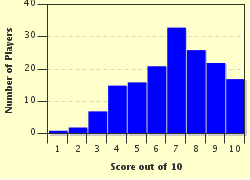Quiz Answer Key and Fun Facts
1. The teddy bear originates with a toy manufactured to honour US President Theodore Roosevelt, and an incident that happened when he was out hunting one day. What was this incident?
2. After receiving permission from the President to name this bear after him, the product became an immediate success and sales shot through the roof. Originally, it was known as Teddy's Bear - and what other name?
3. Rupert Bear, another favourite with children everywhere, is a popular fellow who lives with his parents in the small village of Nutwood. In which country is this fictional village located?
4. Who hasn't heard of Winnie-the-Pooh, Christopher Robin's trouble-attracting teddy bear? How did the Pooh part of his name come about, according to "When We Were Very Young"?
5. Paddington Bear first appeared in print in 1958. An immigrant from another land, which country was the birthplace of Paddington?
6. In which setting is the story of Corduroy Bear placed?
7. The United Kingdom's BBC Children in Need is a charity that has been operating since 1980. With its focus on helping children with disabilities, what is the name of this fine charity's mascot?
8. Using their images on greeting cards was the specific purpose behind the creation of the first Care Bears 1981.
9. Here's some heart warming facts for you. In 1997, an American charity, NAPLC, based in Washington, D.C., launched a very praiseworthy organisation, the Teddy Bear Cops Program. What does this program involve?
10. Sooty is a British gloved puppet bear. He was created by a British puppeteer with the same name as a famous comic British actor. Who was that puppeteer?
Source: Author
Creedy
This quiz was reviewed by FunTrivia editor
WesleyCrusher before going online.
Any errors found in FunTrivia content are routinely corrected through our feedback system.


